Read this blog post in: Português | ગુજરાતી
The Vanzas and Darjis, the weavers and tailors, of the city of Diu celebrate a festival called KAJLO on the chaturthi (fourth day) of Saavana’s Krishna paksha.
The Kajlo consists of a pyramidal figure of quadrilateral shape, built of bamboo and densely lined with betel leaves and with a border of flowers at the angles and the ridge, having at its base a beautiful coconut hanged and covered in dense green betel foliage.
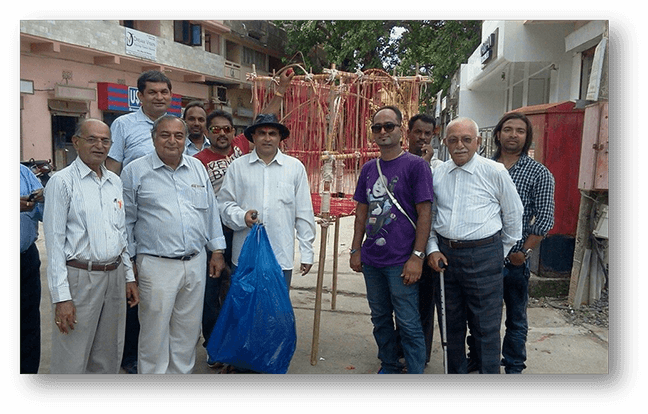
In this photograph, one can see members of the community preparing the Kajlo out of bamboo and betel leaves, in memory of Saint Kabir. Photo courtesy Shreeman Vijay Kumaldas.
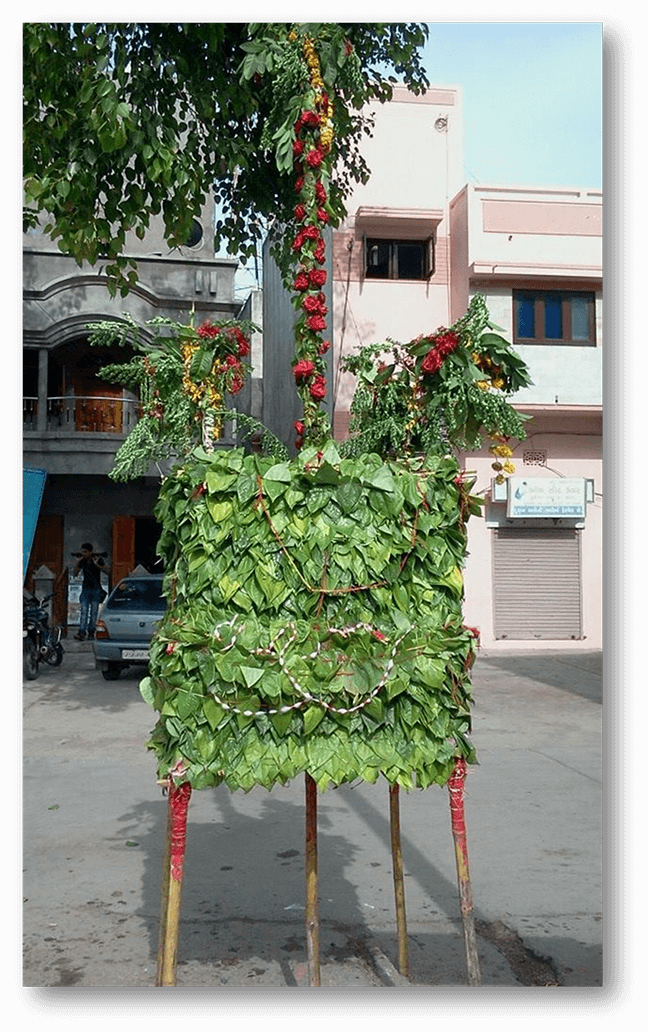
In this photograph, one can see the Kajlo which consists of a pyramidal figure of quadrilateral shape, built of bamboo and densely lined with betel leaves. Photo courtesy Shreeman Vijay Kumaldas.
It is Diu's original festival and is not celebrated anywhere else in India.
Almost at 5 o'clock in the afternoon, the happy religious procession departs from a neighbourhood near the Pharmacy to the Zampa Gateway.

Five members of the community are seen running the Kajlo around in a circle seven times before starting the journey. Photo courtesy Shreeman Vijay Kumaldas.

In this photograph, one can see the Kajlo being taken to its destination accompanied by traditional music and songs. Photo courtesy Shreeman Vijay Kumaldas.
The crowds of people along the way are enormous, lending them a lot of shine, with women and girls wrapped in their rich and showy saris, who, when passing of their idol, throw handfuls of rice in reverent attitude.
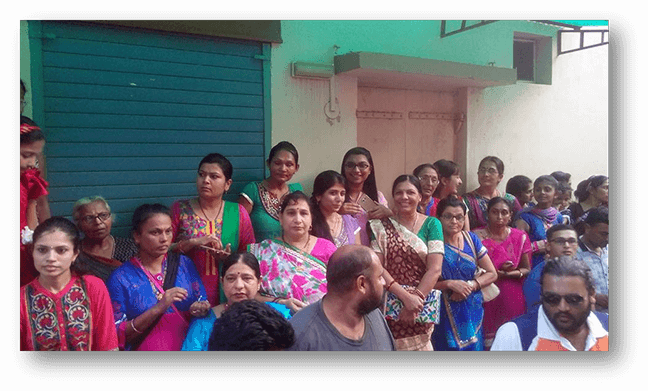
In this photograph, one can see women and girls wrapped in their rich and showy saris, who, when passing of their idol, throw handfuls of rice in reverent attitude. Photo courtesy Shreeman Vijay Kumaldas.
At half past seven, the procession arrives at the place of its purpose, playing music and singing songs.
The scenery there is attractive, picturesque: a vast sea of undulating heads, between warm and strident prayers.
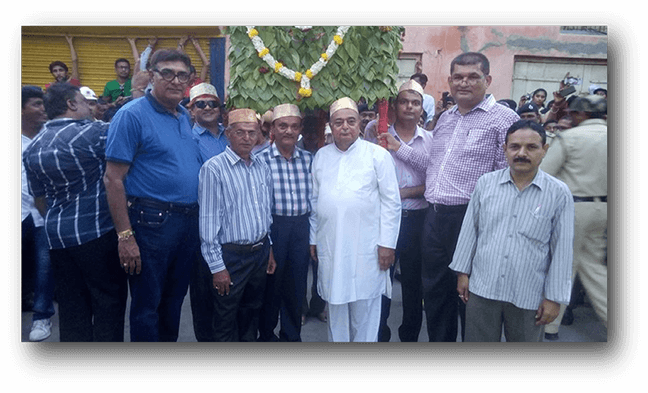
In this photograph, one can see some members of the community holding the Kajlo at the place of its destination. Photo courtesy Shreeman Vijay Kumaldas.

In this photograph, one can see that the crowd of people along the way is enormous. The scenery is attractive and picturesque with a vast sea of undulating heads, between warm and strident prayers. Photo courtesy Shreeman Vijay Kumaldas.
The drivers of Kajlo, in a grave and dignified position, solemnly give it seven rounds, and the frenzied crowd throw themselves into the tray, dismantling it in the midst of a heated struggle. The victory belongs to the lucky man who can catch the sacred coconut and, with skill, escape from the crowd. It is said that this coconut has the virtue of blessing spouses with children.
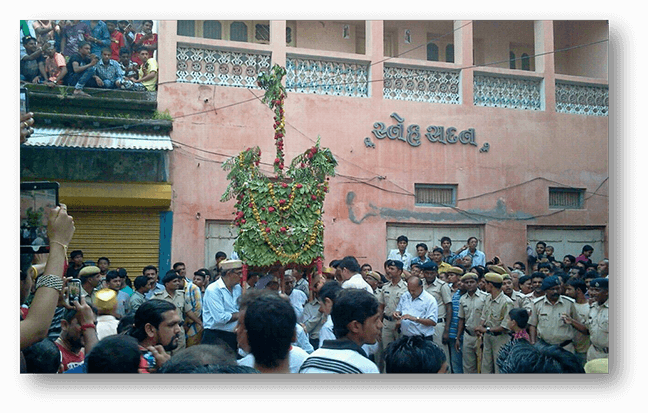
In this photograph, one can see the drivers of the Kajlo, in a grave and dignified position solemnly giving it seven rounds. Photo courtesy Shreeman Vijay Kumaldas.
After the struggle in which at least a small fragment of the Kajlo is sought, one cannot see in the soil a single tiny particle of its spoil.
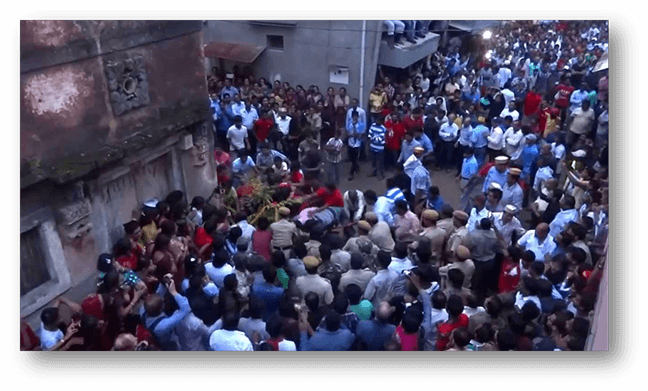
In this photograph, one can see the frenzied crowd throwing themselves at the tray, dismantling it in the midst of a heated struggle.
It is said that this festival originates in the following episode, which became lost in the darkness of the centuries:
An unhappy, pregnant woman was repentant of her weakness on a pilgrimage to the holy places. One day, as she was being purified in the Ganges, she felt the pain of motherhood, and so she came out of the water, and became secure in a half-hidden shelter, where, moments later, she gave birth to a beautiful boy, who was left, at the mercy of chance, though against the will of the unfortunate woman. The Lord, who always watches over the unprotected, sent a fakir, who wandered through those places to collect the innocent child and take him as an adopted son.
The young man, known by the name of Kabir, grew up in virtue and holiness and, as a man, came to Diu. The fame of his religious wisdom attracted a great number of devoted admirers to him, even among the literate brahmins, one of whom, on one occasion, listening to the sermon of the prophet, had inadvertently drank his water, and began lamenting for it, in mourning, of his eternal condemnation.
Kabir calmed him with his authority by all recognised, asserting that he was also a Brahmin of the race, and with a penknife, he traced diagonally in his body, a blood line that was converted by miracle into a true white line known as JANOI, the symbol of the Brahmanic faith.
Beloved and loved by all, Kabir was offered a beautiful party every year on the fourth day after Narieli Purnima, a feast they named KAJLO, deriving from KAJI (a learned and holy man), in honour of the name of their beloved master Kabir. When he died, his corpse turned into a pyramid of verdant betel leaves.
Post by Dipac Canacsinh
Acknowledgements
It is my radiant sentiment to place on record my deepest sense of gratitude to Mr. Pradip Vassantlal for his assistance in the editing and proofreading of the Gujarati version of this article.
I would like to express my gratitude to Mr. Navinchandra Damodar for allowing me to transcribe in Gujarati the rituals of decoration and the puja of the coconut used in the Kajlo.
A special thanks to Mr. Vijay Kumaldas, Mr. Navinchandra Damodar, Mr. Hasmucrai Amarchande and Mr. Samir Puspasseno for providing me with the photographs used in this article.
I thank Mr. Vijay Kumaldas who provided me with the poem of Kabir Bhagat, taken from old documents. Also, my gratitude to Mr. Vasant Aridas and Mr. Hasmucrai Amarchande for providing me with the vaishnav songs that are sung on this occasion.
Thanks also to my cousin, Mr. Rajendra Manharlal, for allowing me to use the videos of Kajlo from 1994 for the purposes of this article.

